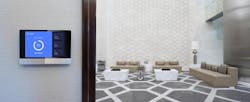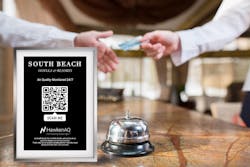How a Cultural Shift in Hotel Air Quality Will Keep People Safe
Hotel indoor air quality has a huge role to play in impacting how hospitality conducts business moving forward. Hotel owners are also still navigating a turbulent market as they reopen to hesitant and even fearful guests. The major concerns for hotels have been cleaning, PPE and social distancing protocols over the last 18 months. With winter rapidly approaching, indoor air quality is even more important, on top of the lingering COVID-19 worries.
According to a recent survey from Carbon Lighthouse, 77% of consumers would consider a hotel’s air quality in deciding where to stay. Additionally, 52% of consumers would be willing to pay more to stay at a hotel with better air quality.
Unfortunately, not enough hotels are equipped with the systems to provide data-driven insights on their air quality, despite consumer demand. Having good filters and HVAC systems in place is obviously necessary, but the consumer appetite for up-to-date information on air quality is also important in influencing a hotel’s air quality facilities.
Let’s examine how both a changing clientele attitude and updating facilities can keep people safe in the context of COVID-19 and beyond.
[Related: Interior Strategies for Better IAQ]
Why is Air Quality So Important?
It’s increasingly becoming mandated for hotels to up the ante in terms of air purification in their enclosed spaces. Hoteliers need to make sure that guests feel completely satisfied in their rooms and the public spaces, such as restaurants, the check-in desk and bars. Natural ventilation is crucial but going that extra step by providing purified air can give hotels a competitive edge. Showing care for the overall health and wellbeing of the guests is a level above in terms of good customer service.
Indoor air quality is also a great avenue for hotels to modernize and be a part of a thriving technological future in hospitality. It allows hotels to update antiquated systems—air quality may have previously been hidden away, but now hotels can utilize visual dashboards that display metrics such as humidity, temperature and CO2 levels. Hotel managers can even consider providing access points through QR codes which take guests straight to the metrics on their mobiles.
[Related: Improving IAQ in the New Normal]
Changes to HVAC Systems and Other Strategies
The most efficient and common way to improve HVAC filtration is with MERV-13 upgrades. It can be expensive to overhaul a system completely, so hotels should try to avoid this by making upgrades to existing systems where possible. Dedicated outside air systems, dehumidification and high-efficiency filters can all be effective in minimizing the spread of viruses such as COVID-19 and other unwanted pathogens.
UV-C light is also a highly effective form of air purification, sterilization and disinfection. It can be combined with HVAC systems to kill air contaminants easily. It represents an alternative to traditional cleaning products where surface disinfectants are in limited supply.
Lastly, there are a few essential measures hotels can take to improve ventilation in their building:
- Increase dilution of indoor air by outdoor air intake with natural ventilation. For example, by opening available windows.
- If HVAC systems are used, they should be regularly inspected, maintained and cleaned. This is crucial as many hotel rooms have been dormant over the past 18 months, which could have resulted in mold growth due to the stagnant enclosed environment. If your hotel operates a regular maintenance procedure, then you will be much safer.
- Disable demand-control ventilation (DCV) controls that might reduce air supply based on temperature or occupancy.
- If recirculation is unavoidable, increase outdoor air exchange by opening windows and minimizing air blowing from one person directly to another.
- Maintain 40-60% humidity to combat the spread of viruses.
Customer and Staff Confidence
For a long time, simply marking a door with a sticker claiming its cleanliness was sufficient for many hotels. However, this just doesn’t convince customers anymore—they want well-presented graphics and evidence that the hotel is doing all they can to keep them safe. Real-time data is available in almost all aspects of our lives, so customers have come to expect it.
Prior to the onset of the COVID-19 pandemic, just 5% of business travelers ranked health and safety as the most important factor when booking a trip, whereas this shot up to 40% during the pandemic. Quite simply, awareness about the adverse effects of bad indoor air quality has increased significantly.
Hotels that rely on cleaning supplies and solvents can increase the levels of volatile organic compounds (VOCs), which can have adverse health effects if staff is exposed to them repeatedly. Low air quality can cause headaches, dry eyes and throats, dizziness, and tiredness. Staff who are uncomfortable will have lower concentration and productivity, which negatively affects the guest’s experience.
We know that air quality management is essential to the hotel industry, as poor indoor air can harm staff, guests, and customers. There is no doubt that moving forward, customers, particularly for corporate purposes, will start to question how clean a hotel’s air is. They may even be prepared to pay more for particularly high air quality or additional facilities that are in place to guarantee a guest’s safety from COVID-19.
Updated HVAC systems and regular monitoring of air quality are essential to acknowledge the shifting attitude of the general public towards air quality. Hotels can use dashboards in the rooms and public areas to clearly communicate air quality parameters and reassure guests in the process.
About the Author:
John Bohlmann is the founder and CEO of HawkenAQ, a building technology startup working to make every building COVID-safe and carbon neutral.
Read next: IAQ Gets an Upgrade During COVID-19
About the Author

Contributed Author
BUILDINGS partners with industry experts to bring you contributed content covering the hot topics for building owners and facility professionals.

